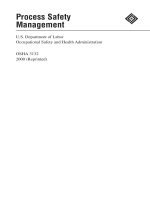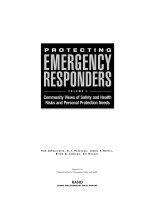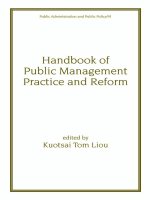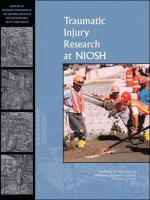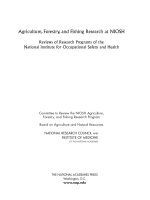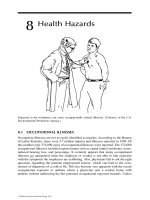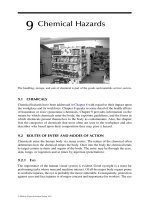handbook of seafood quality, safety, and health applications
Bạn đang xem bản rút gọn của tài liệu. Xem và tải ngay bản đầy đủ của tài liệu tại đây (7.05 MB, 582 trang )
P1: SFK/UKS P2: SFK
fm BLBK298-Alasalvar August 6, 2010 17:11 Trim: 244mm×172mm
P1: SFK/UKS P2: SFK
fm BLBK298-Alasalvar August 12, 2010 13:7 Trim: 244mm×172mm
Handbook of Seafood Quality, Safety and
Health Applications
P1: SFK/UKS P2: SFK
fm BLBK298-Alasalvar August 12, 2010 13:7 Trim: 244mm×172mm
P1: SFK/UKS P2: SFK
fm BLBK298-Alasalvar August 12, 2010 13:7 Trim: 244mm×172mm
Handbook of Seafood Quality, Safety and
Health Applications
Edited by
Associate Professor Cesarettin Alasalvar
T
¨
UB
˙
ITAK Marmara Research Centre
Food Institute, Turkey
Professor Fereidoon Shahidi
Department of Biochemistry
Memorial University of Newfoundland, Canada
Professor Kazuo Miyashita
Faculty of Fisheries Sciences
Hokkaido University, Japan
Dr Udaya Wanasundara
POS Pilot Plant Corporation
Canada
A John Wiley & Sons, Ltd., Publication
P1: SFK/UKS P2: SFK
fm BLBK298-Alasalvar August 12, 2010 13:7 Trim: 244mm×172mm
This edition firs published 2011
C
2011 by Blackwell Publishing Ltd.
Blackwell Publishing was acquired by John Wiley & Sons in February 2007. Blackwell’s publishing programme
has been merged with Wiley’s global Scientific Technical, and Medical business to form Wiley-Blackwell.
Registered offic
John Wiley & Sons Ltd, The Atrium, Southern Gate, Chichester, West Sussex, PO19 8SQ, UK
Editorial office
9600 Garsington Road, Oxford, OX4 2DQ, UK
The Atrium, Southern Gate, Chichester, West Sussex, PO19 8SQ, UK
2121 State Avenue, Ames, Iowa 50014-8300, USA
For details of our global editorial offices for customer services and for information about how to apply for
permission to
reuse the
copyright material in this book please see our website at www.wiley.com/wiley-blackwell.
The right of the authors to be identifie as the authors of this work has been asserted in accordance with the UK
Copyright, Designs and Patents Act 1988.
All rights reserved. No part of this publication may be reproduced, stored in a retrieval system, or transmitted, in
any form or by any means, electronic, mechanical, photocopying, recording or otherwise, except as permitted by
the UK Copyright, Designs and Patents Act 1988, without the prior permission of the publisher.
Wiley also publishes its books in a variety of electronic formats. Some content that appears in print may not be
available in electronic books.
Designations used by companies to distinguish their products are often claimed as trademarks. All brand names
and product names used in this book are trade names, service marks, trademarks or registered trademarks of their
respective owners. The publisher is not associated with any product or vendor mentioned in this book. This
publication is designed to provide accurate and authoritative information in regard to the subject matter covered.
It is sold on the understanding that the publisher is not engaged in rendering professional services. If professional
advice or other expert assistance is required, the services of a competent professional should be sought.
Library of Congress Cataloging-in-Publication Data
Handbook of seafood quality, safety, and health applications / edited by Cesarettin Alasalvar . . . [et al.].
p. cm.
Includes bibliographical references and index.
ISBN 978-1-4051-8070-2 (hardback : alk. paper) 1. Seafood–Health aspects. 2. Fish as food.
3. Seafood–Safety measures. 4. Fishery processing. I. Alasalvar, Cesarettin.
QP144.F56H36 2010
363.19
26–dc22
2010007707
A catalogue record for this book is available from the British Library.
This book is published in the following electronic formats: ePDF (9781444325553); Wiley Online Library
(9781444325546)
Set in 10/12 pt Times by Aptara
R
Inc., New Delhi, India
1 2011
P1: SFK/UKS P2: SFK
fm BLBK298-Alasalvar August 12, 2010 13:7 Trim: 244mm×172mm
Contents
Preface xxiii
Contributors xxv
1 Seafood quality, safety, and health applications: an overview 1
Cesarettin Alasalvar, Fereidoon Shahidi, Kazuo Miyashita, and
Udaya Wanasundara
1.1 Introduction 1
1.2 Seafood quality 1
1.3 Seafood safety 3
1.4 Health applications of seafood 5
1.5 Conclusions 7
References 7
PART I SEAFOOD QUALITY
2 Practical evaluation of fis quality by objective, subjective,
and statistical testing 13
Cesarettin Alasalvar, John M. Grigor, and Zulfiqu Ali
2.1 Introduction 13
2.2 Methods used for fis freshness and quality assessment: from source
to the consumer 14
2.2.1 Latest developments in sensory methods 14
2.2.2 Latest developments in non-sensory methods 16
2.2.2.1 Chemical/biochemical methods 16
2.2.2.2 Physico-chemical methods 16
2.2.2.3 Microbiological/biological methods 17
2.2.3 Latest developments in statistical methods 19
2.2.4 Consumer testing for fis quality perception 21
2.3 Potential use of micro- and nanotechnologies 22
2.4 Conclusions 24
References 24
3 Sensory evaluation of fis freshness and eating qualities 29
David P. Green
3.1 Introduction 29
3.2 Methods for sensory evaluation of fis 30
3.2.1 Torry scale 30
3.2.2 European Union Scheme 30
3.2.3 Quality Index Method 33
P1: SFK/UKS P2: SFK
fm BLBK298-Alasalvar August 12, 2010 13:7 Trim: 244mm×172mm
vi Contents
3.3 Pre-harvest factors affecting freshness 34
3.4 Post-harvest factors affecting freshness 34
3.5 Environmental taints 35
3.6 Extending freshness and shelf-life in fis 37
3.7 Conclusions 37
References 37
4 Sensometric and chemometric approaches to seafood fl vour 39
Kae Morita and Tetsuo Aishima
4.1 Introduction 39
4.2 Sensometric approach to seafood fl vour 40
4.3 Chemometric approach to seafood fl vour 41
4.3.1 Experimental designs and optimization 41
4.3.2 Pattern recognition 42
4.3.3 Multivariate regression analysis 43
4.3.3.1 Green 44
4.3.3.2 Grilled fis 44
4.3.3.3 Fried chicken 44
4.3.3.4 Cooked fish sweet, canned tuna, and roasted
soy sauce 44
4.3.4 Compound-sensory mapping 46
4.4 Conclusions 47
References 48
5 Instrumental analysis of seafood fl vour 50
Hun Kim and Keith R. Cadwallader
5.1 Introduction 50
5.2 Isolation of volatile fl vour compounds 51
5.2.1 Headspace sampling 51
5.2.1.1 Static headspace sampling 51
5.2.1.2 Dynamic headspace sampling 54
5.2.1.3 Solid phase microextraction 54
5.2.1.4 Sorptive extraction 54
5.2.2 Solvent extraction and distillation extractions 55
5.2.2.1 Direct solvent extraction 55
5.2.2.2 Steam distillation extraction 55
5.2.2.3 High vacuum distillation extraction 56
5.3 Instrumental analysis of volatile fl vour compounds 56
5.3.1 Gas chromatography 56
5.3.1.1 Gas chromatography-olfactometry
(sensory-directed analytical techniques) 56
5.3.1.2 Multidimensional gas chromatography 59
5.3.2 Mass spectrometry 59
5.3.2.1 High resolution mass spectrometry 59
5.3.2.2 Selected ion monitoring mass spectrometry 60
5.3.2.3 Chemical ionization mass spectrometry 60
5.3.2.4 Negative chemical ionization mass spectrometry 60
P1: SFK/UKS P2: SFK
fm BLBK298-Alasalvar August 12, 2010 13:7 Trim: 244mm×172mm
Contents vii
5.3.2.5 Time-of-fligh mass spectrometry 61
5.3.3 Electronic nose 61
5.4 Conclusions 61
References 62
6 Quality assessment of aquatic foods by machine vision, electronic nose,
and electronic tongue 68
Figen Korel and Murat
¨
O. Balaban
6.1 Introduction 68
6.2 Visual quality 68
6.2.1 Visual quality determination based on size and
shape 69
6.2.2 Visual quality determination based on colour 69
6.3 Smell-related quality 71
6.4 Taste-related quality 72
6.5 Combination of machine vision system and electronic nose 75
6.6 Conclusions 75
References 76
7 Effects of nutrition and aquaculture practices on fis quality 82
Kriton Grigorakis
7.1 Introduction 82
7.2 The role of muscle composition and fat deposition in fis quality 82
7.3 Effect of feeding and aquaculture practices on quality characteristics 83
7.3.1 Feeding and its impact on fis fat 83
7.3.1.1 Feeding intensity and dietary fat 84
7.3.1.2 Fish oil substitution 88
7.3.1.3 Finishing diets 88
7.3.1.4 Fasting 89
7.3.1.5 Factors other than feeding that affect fis fat 89
7.3.2 Feeding and handling: effect on muscle protein/amino
acids 89
7.3.3 Feeding and aquaculture handling: effects on colour 89
7.3.4 Feeding and body shape 90
7.3.5 Feeding and effect on taste and fl vour 90
7.3.6 Dietary and handling impacts on texture 90
7.3.7 Impact of aquaculture handling and killing procedure on
post-mortem quality 91
7.3.8 Effect of feeding on post-mortem quality and technological
properties 91
7.4 Conclusions 92
References 92
8 Lipid oxidation, odour, and colour of fis fles 96
Jeong-Ho Sohn and Toshiaki Ohshima
8.1 Introduction 96
8.2 Quantitative determination methodology of total lipid
hydroperoxides by a fl w injection analysis system 97
P1: SFK/UKS P2: SFK
fm BLBK298-Alasalvar August 12, 2010 13:7 Trim: 244mm×172mm
viii Contents
8.3 Lipid oxidation in ordinary and dark muscle of fis 98
8.4 Effects of bleeding and perfusion of yellowtail on post-mortem lipid
oxidation of ordinary and dark muscles 102
8.5 Conclusions 105
References 105
9 Blackening of crustaceans during storage: mechanism and prevention 109
Kohsuke Adachi and Takashi Hirata
9.1 Introduction 109
9.2 Phylogenetic position of prawns: the relation of PO and Hc 110
9.3 Biosynthetic pathway of melanin 111
9.4 Significanc of melanisation in arthropods: pre-harvest and
post-harvest 111
9.5 Biochemical characterisation of proPO and PO 112
9.6 The relationship of PO and melanogenesis in prawns 113
9.7 Hemocyanin and its enzymatic activation 114
9.8 The relationship of frozen storage and blackening 116
9.9 Prevention of melanosis in prawns 117
9.10 Conclusions 117
References 117
10 Quality of freshwater products 119
Masaki Kaneniwa
10.1 Introduction 119
10.2 Lipid and fatty acid composition in freshwater fis 119
10.3 The effect of dietary fatty acid composition in cultured freshwater
fis 123
10.4 Enzymatic hydrolysis of lipid in the muscle of freshwater fis 125
10.5 Quality of frozen surimi from freshwater fis meat 127
10.6 Conclusions 127
10.7 Acknowledgements 127
References 128
11 Texture measurements in fis and fis products 130
Zulema Coppes-Petricorena
11.1 Introduction 130
11.2 Measurement of fis texture 131
11.2.1 Instrumental versus sensory methods 131
11.2.2 Raw and cooked fis products 131
11.2.3 Sensory evaluation 132
11.2.4 Texture measurement of fis fles 132
11.3 Relevance of measuring texture in fis products 132
11.3.1 Firmness: a quality for good fis texture 133
11.3.2 Muscle structure of fis fles 133
11.3.3 Muscle cell biology 133
11.3.4 Physical exercise 134
P1: SFK/UKS P2: SFK
fm BLBK298-Alasalvar August 12, 2010 13:7 Trim: 244mm×172mm
Contents ix
11.4 Textural measurements of fis products 134
11.5 Conclusions 134
11.6 Acknowledgements 136
References 136
12 Quality and safety of packaging materials for aquatic products 139
T.K. Srinivasa Gopal and C.N. Ravi Shankar
12.1 Introduction 139
12.2 Packaging materials 139
12.2.1 Glass containers 139
12.2.2 Metal cans 139
12.2.3 Paper 141
12.2.4 Cellophanes 141
12.2.5 Polyethylene 141
12.2.6 Polypropylene (PP) 142
12.2.7 Polystyrene (PS) 142
12.2.8 Polyester 143
12.2.9 Polyamides (nylon) 143
12.2.10 Polyvinyl chloride (PVC) 143
12.2.11 Ionomers 143
12.2.12 Copolymers 144
12.2.13 Aluminium foil 144
12.3 Packaging requirements for fis products 144
12.3.1 Packaging of fresh fis 144
12.3.2 For bulk packaging 144
12.3.3 Modifie atmosphere packaging (MAP) 145
12.3.4 Packaging of frozen fis 145
12.3.5 Packaging of surimi 146
12.3.6 Battered and breaded products 147
12.3.7 Packaging of dried fisher products 147
12.3.8 Packaging of canned fis 147
12.3.9 Ready to serve fis products in retortable pouches 148
12.3.10 Fish sausage 148
12.3.11 Accelerated freeze dried (AFD) products 148
12.3.12 Fish pickles 149
12.3.13 Fish soup powder 149
12.3.14 Shark fi rays 149
12.3.15 Chitin/chitosan 149
12.4 Safety aspects of packaging materials 150
12.5 Conclusions 153
References 154
13 Fish mince: cryostabilization and product formulation 156
Chong M. Lee
13.1 Introduction 156
13.2 Background information 156
13.2.1 Rationale for the development of fis mince technology 156
13.2.2 Source of fis mince 157
P1: SFK/UKS P2: SFK
fm BLBK298-Alasalvar August 12, 2010 13:7 Trim: 244mm×172mm
x Contents
13.3 Manufacture of fis mince and cryostabilization 158
13.3.1 Manufacture of fis mince 158
13.3.1.1 Manufacture of fis mince from ground
white fis 159
13.3.1.2 Manufacture of fis mince from pelagic
dark fis 160
13.3.2 Quality evaluation of fis mince 162
13.3.3 Cryostabilization of fis mince 162
13.4 Formulation of fis mince-based products in relation to ingredients
and sensory quality 164
13.4.1 Ingredients and processing methods on texture 165
13.4.2 Freeze-thaw stability of uncooked mince-based
products 166
13.4.3 Colour management 167
13.4.4 Flavour enhancement 167
13.4.5 Application of surimi-fis mince blend in fis cake and
kamaboko products 167
13.5 Conclusions 168
13.6 Acknowledgements 168
References 168
14 New trends in species identificatio of fisher products 171
Hartmut Rehbein
14.1 Introduction 171
14.2 Background information 171
14.3 Microarrays 172
14.4 Messenger RNA analysis 174
14.5 Detection of allergenic fis and shellfis 174
14.6 Determination of origin and stock assignment of fis 175
14.7 Data bases 176
14.7.1 FishTrace 177
14.7.2 FishGen 177
14.7.3 AFLP 177
14.7.4 Validation 177
14.7.5 FischDB 177
14.7.6 RFE 178
14.8 Conclusions 178
References 178
15 An emerging powerful technique: NMR applications on quality
assessments of fis and related products 181
Somer Bekiro
˘
glu
15.1 Introduction 181
15.2 Low-fiel (time-domain) NMR applications 182
15.2.1 Water, lipids, and others 182
15.2.2 On-line and off-line applications: quality
control 184
P1: SFK/UKS P2: SFK
fm BLBK298-Alasalvar August 12, 2010 13:7 Trim: 244mm×172mm
Contents xi
15.3 High-fiel NMR applications 184
15.3.1 Quantitative NMR applications and chemical
compositions 185
15.3.2 Fingerprinting 186
15.3.3 The future: fis metabon(l)omics 187
15.3.4 NMR and authenticity 187
15.4 Projections on MRI applications 188
15.5 Conclusions 189
References 190
PART II SEAFOOD SAFETY
16 Food-borne pathogens in seafood and their control 197
Dominic Kasujja Bagenda and Koji Yamazaki
16.1 Introduction 197
16.2 Major food-borne pathogens related to seafood 198
16.3 Current trends in control of seafood-borne pathogens 199
16.3.1 Biological methods of controlling pathogens in seafood 199
16.3.2 Physical and chemical methods of controlling pathogens
in seafood 201
16.3.3 Hurdle technology for controlling pathogens in seafood 203
16.4 Conclusions 203
References 203
17 Novel approaches in seafood preservation techniques 206
Fatih
¨
Ozogul, Yesim
¨
Ozogul, and Esmeray Kuley Boga
17.1 Introduction 206
17.2 Seafood preservation techniques 206
17.2.1 Modifie atmosphere packaging (MAP) 206
17.2.2 Irradiation technology 207
17.2.3 Ozone (O
3
) preservation technique 208
17.2.4 Physical preservation methods 209
17.2.4.1 Pulsed electric field (PEF) 209
17.2.4.2 Ultraviolet (UV) radiation 209
17.2.4.3 Oscillatory magnetic field (OMF) 210
17.2.4.4 High pressure processing (HPP) 210
17.2.5 Ultrasound as a preservation technology 211
17.2.6 High intensity light 211
17.3 Conclusions 212
References 212
18 Essential oils: natural antimicrobials for fis preservation 217
Barakat S.M. Mahmoud and Kazuo Miyashita
18.1 Introduction 217
P1: SFK/UKS P2: SFK
fm BLBK298-Alasalvar August 12, 2010 13:7 Trim: 244mm×172mm
xii Contents
18.2 Essential oils 217
18.2.1 Chemistry of essential oils 217
18.2.2 Active components of essential oils 218
18.2.3 Bacterial sensitivity to essential oils and their
components 218
18.2.4 Phenolic compounds 218
18.3 Application of essential oils to fis preservation 219
18.3.1 Effect of essential oils on fis spoilage bacteria 219
18.3.2 Effect of essential oils on shelf-life of fis 220
18.3.3 Antimicrobial effect of combined treatment of essential
oils with other antimicrobial agents 221
18.4 Conclusions 221
References 222
19 Rapid methods for the identificatio of seafood micro-organisms 226
Brian H. Himelbloom, Alexandra C.M. Oliveira, and
Thombathu S. Shetty
19.1 Introduction 226
19.2 Non-molecular (phenotyping) 226
19.2.1 Analytab products (api
R
) 226
19.2.2 Biolog Inc. 226
19.2.3 Microbial Identificatio Inc. (MIDI) 227
19.2.4 Limitations for phenotypic identificatio of seafood and
aquaculture bacteria 227
19.3 Molecular (genotyping) 228
19.3.1 Polymerase chain reaction (PCR) and real-time or
quantitative PCR (qPCR) 228
19.3.2 Molecular subtyping techniques 228
19.3.3 Commercially-available systems 231
19.3.4 Polyphasic taxonomy 231
19.4 Conclusions 231
19.5 Acknowledgements 231
References 232
20 Using predictive models for the shelf-life and safety of seafood 237
Graham C. Fletcher
20.1 Introduction 237
20.2 Predicting contamination 238
20.3 Predicting microbiological safety in chilled storage 238
20.3.1 Histamine production 238
20.3.2 Growth of Listeria monocytogenes in lightly preserved
seafood 240
20.3.3 Toxin production by Clostridium botulinum 241
20.3.4 Other hazards 241
20.4 Predicting spoilage and shelf-life in chilled storage 242
20.4.1 The square root model as a secondary model 242
20.4.2 Linear responses as primary models 242
P1: SFK/UKS P2: SFK
fm BLBK298-Alasalvar August 12, 2010 13:7 Trim: 244mm×172mm
Contents xiii
20.4.3 Specifi spoilage organisms 242
20.4.4 Microbial growth under modifie atmosphere
packaging 243
20.4.5 Use of time-temperature indicators 243
20.4.6 Instrumental methods to detect spoilage 243
20.5 Predicting spoilage and shelf-life in frozen storage 244
20.6 Predicting inactivation 244
20.7 Conclusions 246
References 246
21 Mathematical modelling of shrimp cooking 251
Ferruh Erdo
˘
gdu and Murat
¨
O. Balaban
21.1 Introduction 251
21.2 Exact solutions 252
21.3 Numerical solutions 253
21.4 A numerical model for shrimp cooking 253
21.5 Applications 257
21.6 Conclusions 258
21.7 Nomenclature 258
References 259
22 Transgenic/transgenic modifie fis 261
Jenn-Kan Lu, Jen-Leih Wu, and Meng-Tsan Chiang
22.1 Introduction 261
22.2 Methodology of gene transfer in fis 261
22.2.1 Microinjection 262
22.2.2 Electroporation 262
22.2.3 Viral-mediated gene transfer (VMGT) 262
22.2.4 The fate of the transgene 263
22.2.5 Why study gene transfer in aquatic animals? 264
22.2.6 Applications of gene transfer technique in aquaculture 265
22.3 Food safety of transgenic fis 266
22.3.1 General concept 266
22.3.2 The gene product 267
22.4 Regulations of transgenic animals including aquatic animals 269
22.4.1 Environmental issues 269
22.4.2 Human health issues 270
22.4.3 Trade 270
22.4.4 Intellectual property protection 270
22.4.5 Labelling 270
22.4.6 Ethics 271
22.4.7 Public perceptions 271
22.5 Conclusions 271
References 272
23 Molecular detection of pathogens in seafood 275
Iddya Karunasagar and Indrani Karunasagar
23.1 Introduction 275
P1: SFK/UKS P2: SFK
fm BLBK298-Alasalvar August 12, 2010 13:7 Trim: 244mm×172mm
xiv Contents
23.2 Probe hybridisation methods 275
23.3 Nucleic acid amplificatio methods 278
23.3.1 Detection of bacterial pathogens 278
23.3.2 Detection of viral pathogens 282
23.3.3 Detection of parasites 282
23.3.4 Real-time PCR assays 283
23.3.5 DNA microarray assays 284
23.4 Conclusions 284
References 286
24 DNA-based detection of commercial fis species 290
Rosalee S. Rasmussen and Michael T. Morrissey
24.1 Introduction 290
24.2 DNA-based methods and gene targets 291
24.2.1 DNA-based methods 291
24.2.2 Gene targets 293
24.3 Major collaborative efforts 295
24.3.1 FishTrace 295
24.3.2 DNA barcoding 296
24.3.2.1 DNA barcoding of fis 296
24.3.2.2 DNA barcoding for the detection of fis species
substitution 297
24.4 Conclusions 299
24.5 Acknowledgements 300
References 300
25 Seafoods and environmental contaminants 303
Beraat
¨
Ozc¸elik,
¨
Umran Uygun, and Banu Bayram
25.1 Introduction 303
25.2 Persistent environmental pollutants (PEPs) 303
25.2.1 Organohalogen compounds (OCs) 303
25.2.1.1 Dioxin and dioxin-like compounds 304
25.2.1.2 Brominated flam retardants (BFRs) 305
25.2.1.3 Polychlorinated napthalenes (PCNs) 305
25.2.1.4 Organochlorine pesticides (OCPs) 305
25.2.2 Heavy metals 306
25.3 Aquaculture practices as a source of persistent contaminants 308
25.4 Factors affecting the occurrence of PEPs in seafood 310
25.5 Risk assessment and regulations 310
25.6 Policies to reduce exposure to PEPs 311
25.7 Conclusions 311
References 312
26 Oxidation and stability of food-grade fis oil: role of antioxidants 317
Weerasinghe M. Indrasena and Colin J. Barrow
26.1 Introduction 317
P1: SFK/UKS P2: SFK
fm BLBK298-Alasalvar August 12, 2010 13:7 Trim: 244mm×172mm
Contents xv
26.2 Process of oxidation 317
26.2.1 Autoxidation 317
26.2.1.1 Initiation 318
26.2.1.2 Propagation 318
26.2.1.3 Termination 318
26.2.2 Photooxidation 318
26.3 Factors affecting the rate of lipid oxidation 319
26.3.1 Oxygen 319
26.3.2 Physical form of oil 319
26.3.3 Positional distribution of unsaturated fatty acids in the
TAG molecule 319
26.3.4 Temperature 320
26.3.5 Microcomponents in the oil 320
26.3.5.1 Hydroperoxides 320
26.3.5.2 Free fatty acids 320
26.3.5.3 Thermally oxidized lipid compounds 320
26.3.5.4 Heavy metals 320
26.3.5.5 Pigments 320
26.3.5.6 Non lipid components in food 321
26.4 Food-grade fis oil 321
26.5 Control of lipid oxidation and improvement of the stability
of fis oil 322
26.5.1 Careful handling and storage 322
26.5.2 Inhibiting oxidation 322
26.5.2.1 Inhibiting photooxidation 322
26.5.2.2 Inhibiting autoxidation 325
26.6 Antioxidants 325
26.6.1 Mechanism of phenolic antioxidants 327
26.6.2 Factors affecting the antioxidant activity of tocopherols 328
26.6.2.1 Concentration and type of tocopherol 328
26.6.2.2 Oxygen and temperature 329
26.6.2.3 Light 329
26.6.2.4 Substrate 329
26.6.2.5 Polarity and pH of the medium 330
26.6.2.6 Synergistic nature of tocopherols and other
antioxidants 330
26.7 Selection of an antioxidant 331
26.8 Conclusions 332
References 332
27 Global legislation for fis safety and quality 335
Ioannis S. Arvanitoyannis and Persefoni Tserkezou
27.1 Introduction 335
27.2 Global legislation in fis and fisher products 335
27.2.1 EU legislation 335
27.2.2 US legislation 338
27.2.3 Canadian legislation 341
P1: SFK/UKS P2: SFK
fm BLBK298-Alasalvar August 12, 2010 13:7 Trim: 244mm×172mm
xvi Contents
27.2.4 Australian legislation 343
27.2.5 Japanese legislation 344
27.3 Conclusions 345
References 346
28 Food safety and quality systems (ISO 22000:2005) in the seafood sector 348
Ioannis S. Arvanitoyannis
28.1 Introduction 348
28.2 Salmon 349
28.3 Surimi 351
28.4 Crabs 363
28.5 Conclusions 363
References 364
PART III HEALTH APPLICATIONS OF SEAFOOD
29 Health benefit associated with seafood consumption 369
Maria Leonor Nunes, Narcisa Maria Bandarra, and Irineu Batista
29.1 Introduction 369
29.2 Nutritional value 369
29.2.1 Protein 370
29.2.2 Lipids 370
29.2.3 Minerals and vitamins 372
29.3 Effect of cooking on nutritional value 372
29.4 Health benefit of seafood 373
29.4.1 Essential n-3 fatty acids 373
29.4.2 Cardioprotector effect/coronary heart disease (CHD) 373
29.4.3 Hypertension 374
29.4.4 Diabetes 375
29.4.5 Cancer 375
29.4.6 Other effects 376
29.5 Conclusions 376
References 376
30 A new approach to the functional improvement of fis meat proteins 380
Hiroki Saeki
30.1 Introduction 380
30.2 Reaction between fis meat protein and reducing sugars through the
Maillard reaction 381
30.3 Suppression of protein denaturation at the Maillard reaction by
controlling the reaction humidity 382
30.4 Water solubilisation of fis Mf protein by glycosylation 382
30.5 Molecular mechanism of water solubilisation by glycosylation 383
30.6 Improvement of the thermal stability and emulsion-forming ability
of fis myofibrilla protein 385
P1: SFK/UKS P2: SFK
fm BLBK298-Alasalvar August 12, 2010 13:7 Trim: 244mm×172mm
Contents xvii
30.7 Complex utilisation of under-utilised marine bioresources using the
glycosylation system 386
30.8 Food safety check of fis meat protein conjugated with AO 387
30.9 Conclusions 387
References 388
31 Value addition to seafood processing discards 390
Sachindra M. Nakkarike, Bhaskar Narayan, Masashi Hosokawa, and Kazuo
Miyashita
31.1 Introduction 390
31.2 Enzymes from seafood discards 390
31.3 Protein hydrolysate and bioactive peptides from seafood discards 392
31.4 Collagen and gelatin from fis discards 393
31.5 Chitin and chitosan from crustacean discards 394
31.6 Carotenoids from crustacean discards 395
31.7 Conclusions 397
References 398
32 Role of marine foods in prevention of obesity 402
Shigeru Nakajima
32.1 Introduction 402
32.2 Anti-obesity effect of marine lipids 403
32.2.1 Molecular mechanism for anti-obesity effect of
marine lipids 403
32.2.2 Traditional marine products as a good source of
anti-obesity PUFA, EPA, and DHA 404
32.3 Anti-obesity effect of histidine 405
32.3.1 Fish protein 405
32.3.2 Suppression of food intake by histidine 406
32.3.3 Underlying mechanism for effect of histidine 408
32.4 Conclusions 410
References 410
33 Microencapsulation, nanoencapsulation, edible film and coating
applications in seafood processing 414
Subramaniam Sathivel and Don Kramer
33.1 Introduction 414
33.2 Application of microencapsulation technology in fis oil 414
33.3 Nanoencapsulated fis oil 416
33.4 Edible fil and coating applications in seafood 417
33.5 Conclusions 420
References 420
34 Fish oil extraction, purification and its properties 423
Subramaniam Sathivel
34.1 Introduction 423
P1: SFK/UKS P2: SFK
fm BLBK298-Alasalvar August 12, 2010 13:7 Trim: 244mm×172mm
xviii Contents
34.2 Extraction 423
34.2.1 Degumming 424
34.2.2 Neutralization (alkali refining 425
34.2.3 Bleaching 425
34.2.4 Deodorization 426
34.2.5 Fractionation or winterization 426
34.3 Fish oil properties 427
34.3.1 Thermal properties of fis oil 427
34.3.2 Rheological properties of fis oil 428
34.4 Conclusions 429
References 430
35 Nutraceutical quality of shellfis 433
Bonnie Sun Pan
35.1 Introduction 433
35.2 Chemical compositions 433
35.2.1 Proximate composition 433
35.2.2 Minerals 434
35.2.3 Extractive nitrogenous compounds 434
35.2.4 Lipid and sterols 434
35.3 Functional activities 435
35.3.1 Antioxidative activity 435
35.3.2 Hypolipidemia and hypocholesterolemia activity 435
35.3.3 Immunity regulation activity 436
35.3.4 Anti-cancer activity 438
35.3.5 Hepatoprotective activity 438
35.4 Functional clam products 439
35.4.1 Clam essence 439
35.4.2 Clam hydrolysates 439
35.4.2.1 Antioxidative activities 440
35.4.2.2 ACE-inhibitory activities 440
35.5 Conclusions 440
35.6 Acknowledgements 441
References 441
36 Marine oils and other marine nutraceuticals 444
Fereidoon Shahidi and Cesarettin Alasalvar
36.1 Introduction 444
36.2 Specialty and nutraceutical lipids 444
36.3 Bioactive peptides and proteins from marine resources 447
36.4 Chitin, chitosan, chitosan oligomers, and glucosamine 448
36.5 Enzymes 449
36.6 Carotenoids 450
36.7 Minerals and calcium 450
36.8 Shark cartilage, chondroitin sulphate, and squalene 451
36.9 Other nutraceuticals from marine resources 451
36.10 Conclusions 451
References 452
P1: SFK/UKS P2: SFK
fm BLBK298-Alasalvar August 12, 2010 13:7 Trim: 244mm×172mm
Contents xix
37 Nutraceuticals and bioactives from marine algae 455
S.P.J. Namal Senanayake, Naseer Ahmed, and Jaouad Fichtali
37.1 Introduction 455
37.2 Carotenoids 456
37.3 Phycobilins 458
37.4 Polysaccharides 459
37.5 Omega-3 oils 460
37.5.1 Characteristics of microalgal oils 461
37.6 Conclusions 462
References 462
38 Preparative and industrial-scale isolation and purificatio of omega-3
polyunsaturated fatty acids from marine sources 464
Udaya Wanasundara
38.1 Introduction 464
38.2 Concentration methods of n-3 PUFA 465
38.2.1 Chromatographic methods 465
38.2.1.1 Counter-current chromatography 466
38.2.2 Supercritical flui extraction method 468
38.2.3 Low-temperature crystallization method 468
38.2.4 Fatty acid–salt solubility method 469
38.2.5 Distillation method 470
38.2.6 Enzymatic methods 470
38.2.6.1 Lipase-catalyzed hydrolysis 470
38.2.6.2 Lipase-catalyzed esterificatio 471
38.2.7 Urea complexation method 472
38.3 Conclusions 473
References 473
39 Marine oil processing and application in food products 476
Fereidoon Shahidi
39.1 Introduction 476
39.2 Marine oil processing 476
39.3 Enriched omega-3 oils 478
39.4 Application of the omega-3 fatty acids/oils 479
39.5 Conclusions 482
References 482
40 Bioactive peptides from seafood and their health effects 485
Anusha G.P. Samaranayaka and Eunice C.Y. Li-Chan
40.1 Introduction 485
40.2 Sources of bioactive peptides from seafood 485
40.2.1 Enzymatic production of protein hydrolysates 485
40.2.2 Formation of bioactive peptides by food processing and
gastrointestinal (GI) digestion 487
40.2.3 Endogenous bioactive peptides from seafood 487
P1: SFK/UKS P2: SFK
fm BLBK298-Alasalvar August 12, 2010 13:7 Trim: 244mm×172mm
xx Contents
40.3 Potential health benefit of bioactive peptides derived from
seafood 487
40.3.1 Antihypertensive peptides 487
40.3.2 Antioxidative peptides 488
40.3.3 Immunomodulatory peptides 488
40.3.4 Neuroactive peptides 488
40.3.5 Hormonal and hormone-regulating peptides 489
40.3.6 Antimicrobial peptides 489
40.3.7 Other bioactive peptides from seafood 489
40.4 Current and future applications 490
40.5 Conclusions 490
References 491
41 Antioxidative properties of fis protein hydrolysates 494
Sivakumar Raghavan, Hordur G. Kristinsson, Gudjon Thorkelsson, and
Ragnar Johannsson
41.1 Introduction 494
41.2 FPH as food antioxidants 495
41.2.1 Effect of enzymes on antioxidative activity 495
41.2.2 Size of peptides on antioxidative activity 497
41.2.3 Composition of FPH 497
41.2.4 Inhibition of primary and secondary lipid oxidation
products 498
41.2.5 Reducing power, radical scavenging, and metal chelating
ability of FPH 499
41.3 Sensory attributes of FPH 500
41.3.1 Effect of hydrolysis on fl vour 500
41.3.2 Effect of enzymes on fl vour profil 500
41.3.3 Processing techniques to reduce off-fl vours and odours
of FPH 501
41.4 Physiological and bioactive properties of FPH 502
41.4.1 Antiproliferative activity and reparative role of FPH 502
41.4.2 Immunomodulatory role of FPH 502
41.5 Conclusions 503
References 503
42 Functional and nutraceutical ingredients from marine macroalgae 508
Tao Wang, Guðr
´
un
´
Olafsd
´
ottir, R
´
osa J
´
onsd
´
ottir, Hordur G. Kristinsson, and
Ragnar Johannsson
42.1 Introduction 508
42.2 Functional and nutraceutical properties of polyphenols from
marine algae 508
42.2.1 Occurrence and chemical structure of algal polyphenols 508
42.2.2 Antioxidant activity of algal polyphenols 510
42.2.2.1 In vitro antioxidant properties of algal
polyphenols 510
P1: SFK/UKS P2: SFK
fm BLBK298-Alasalvar August 12, 2010 13:7 Trim: 244mm×172mm
Contents xxi
42.2.2.2 Antioxidant mechanism and
structure-antioxidant activity relationship of
algal polyphenols 512
42.2.3 Other biological activities of algal polyphenols 512
42.2.3.1 Angiotensin I-converting enzyme (ACE)
inhibitory properties of algal polyphenols 513
42.2.3.2 Human immunodeficien y virus (HIV)
inhibitory properties of algal polyphenols 513
42.3 Functional and nutraceutical properties of sulphated
polysaccharides from marine algae 513
42.3.1 Antioxidant activity of sulphated polysaccharides 514
42.3.2 Other functional properties of sulphated
polysaccharides 514
42.3.2.1 Anticoagulant activities of sulphated
polysaccharides 514
42.3.2.2 Anti-tumour activities of sulphated
polysaccharides 515
42.3.2.3 Antiviral activities of sulphated
polysaccharides 515
42.4 Functional and nutraceutical properties of fucoxanthin from
marine algae 516
42.4.1 Antioxidant activities of fucoxanthin 516
42.4.2 Anti-obesity effects of fucoxanthin 517
42.5 Functional and nutraceutical properties of sterols from marine algae 517
42.5.1 Antioxidant activities of sterols from marine algae 517
42.5.2 Anti-diabetic activities of sterols from marine algae 517
42.6 Functional and nutraceutical properties of bioactive peptides from
marine algae 518
42.6.1 Antihypertensive effects of the peptides derived
from algae 518
42.7 Conclusions 518
References 519
43 Seafood enzymes and their potential industrial application 522
Swapna C. Hathwar, Amit K. Rai, Sachindra M. Nakkarike, and Bhaskar
Narayan
43.1 Introduction 522
43.2 Types of seafood enzymes and their applications 523
43.2.1 Protein-degrading enzymes 523
43.2.1.1 Applications of proteases 523
43.2.2 Lipid-degrading enzymes 527
43.2.2.1 Lipases 527
43.2.2.2 Phospholipases (PL) 528
43.2.2.3 Applications of lipases and their role in
seafood quality 528
43.2.3 Carbohydrate-degrading enzymes 529
43.2.3.1 Alginate lyases 529
P1: SFK/UKS P2: SFK
fm BLBK298-Alasalvar August 12, 2010 13:7 Trim: 244mm×172mm
xxii Contents
43.2.3.2 Chitinase 529
43.2.3.3 Applications of carbohydrate-degrading
enzymes 529
43.2.4 Miscellaneous enzymes 531
43.2.4.1 Lipoxygenase (LOX) 531
43.2.4.2 Myosin ATPases 531
43.2.4.3 Polyphenol oxidases (PPO) 531
43.2.4.4 Transglutaminase (TG) 531
43.2.4.5 Applications of miscellaneous enzymes 532
43.3 Conclusions 532
References 532
Index 536
The colour plate section follows page 260
P1: SFK/UKS P2: SFK
fm BLBK298-Alasalvar August 12, 2010 13:7 Trim: 244mm×172mm
Preface
There has been a growing demand for seafoods due to their perceived health benefits
Seafoods are highly nutritious and provide a wide range of health-promoting compounds.
Safety and quality are two main issues when considering seafoods, since they are highly
perishable products, hence special attention should be paid from the time of the catch to
the time they are prepared for food and consumed. Safety and freshness/quality of seafoods
can be measured by sensory, non-sensory (chemical/biochemical, physico-chemical, and
microbiological/biological), and statistical methods. During the last decade, the situation
has changed dramatically in the seafood area and there has been a rapid development in
the fiel for all three mentioned techniques, some of which are rapid and non-destructive in
nature.
The marine ecosystem is the richest source of life, accounting for more than 80% of
living organisms. Therefore, utilisation of marine resources (fish marine mammals, micro-
and macroalgae, shellfish and invertebrates) for the development of nutraceuticals and
functional foods is a daunting and challenging task. Marine-based nutraceuticals are gaining
recognition due to their unique features, which are not found in terrestrial-based bioresources.
For example, fish marine mammals, and algae are the richest sources of long-chain omega-3
polyunsaturated fatty acids (PUFA) such as eicosapentaenoic acid (EPA), docosapentaenoic
acid (DPA), and docosahexaenoic acid (DHA), which play an important role for health
promotion and disease risk reduction. There are over 8,000 published papers on the health
benefit of EPA, DPA, and DHA. The role of omega-3 PUFA, in a wide range of products
and in the prevention of cardiovascular disease and in the development and function of the
brain, has been well demonstrated.
This book is divided into three sections preceded by an introductory chapter (Chapter 1)
providing an overview of seafood quality, safety, and health applications. The firs section
(Chapters 2–15) describes different aspects of seafood quality; the second section (Chapters
16–28) covers the safety of seafoods; and the fina section (Chapters 29–43) discusses the
health applications of seafood products, particularly marine nutraceuticals and functional
foods. Contributing to this volume are internationally renowned researchers who have
provided a diverse and global perspective of the issues of concern to seafood quality, safety,
and health applications. The book will serve as a resource for those interested in the potential
application of new developments in marine nutraceuticals and functional foods, as well as
the role of science and technology in ensuring safety and quality. Biochemists, chemists,
food scientists/technologists, nutritionists, health professionals, and marine technologists,
from academia, government laboratories, and industry will benefi from this publication.
Although this book is intended primarily as a reference book, it also summarises the current
state of knowledge in key research areas and contains ideas for future work. In addition, it
provides easy-to-read text suitable for teaching advanced undergraduate and post-graduate
courses.


